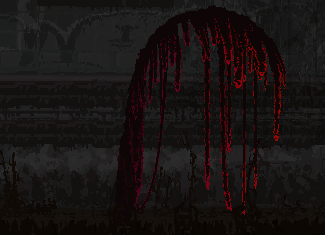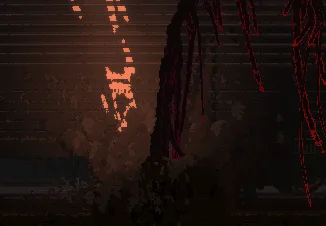
Beyond the dozens of hostile creatures that populate the regions of Rain World, the flora is also a predator to be reckoned with. Many plants have evolved to the point of becoming highly dangerous predators that mainly use mimicry to attract their prey until it is too late.
Worm Grass is a stationary predator found in patches across a few of the game's lower western regions. It cannot be harmed or killed and must be avoided if the player wishes to get past it. A strand of Worm Grass is oval in shape, with a rounded tip and a bright blue eye-mouth, which opens when alerted, and is used to attach onto and drag prey underground. Its length depends on the position within a patch; generally, the longest strands are in the middle, while shorter ones are closer to the edges. Its color depends on length; short Worm Grass is black, while longer strands tend to take on a deep red.
When alerted, Worm Grass stretches toward potential prey in an attempt to grab it. If successful, it limits the creature's mobility before eventually killing it. ![]() Gooieducks can be used to repel both types of Worm Grass and works best when crawling with one in hand without switching directions.
Gooieducks can be used to repel both types of Worm Grass and works best when crawling with one in hand without switching directions.
A creature's mass affects resistance to Worm Grass, meaning heavier ![]() Slugcats like
Slugcats like ![]() Hunter and
Hunter and ![]() Gourmand are more likely to survive it, while lighter Slugcats like
Gourmand are more likely to survive it, while lighter Slugcats like ![]() Monk and
Monk and ![]() Spearmaster are particularly vulnerable to it.
Spearmaster are particularly vulnerable to it.
Black Worm Grass can be found in small patches in ![]() Outskirts,
Outskirts, ![]() Farm Arrays,
Farm Arrays, ![]() Subterranean, and
Subterranean, and ![]() Outer Expanse. While it is possible for Slugcat to run through it, standing in it for even a few seconds makes its grip too strong to overcome, leading to death. Black Worm Grass can be avoided indefinitely by running and jumping to break existing strand attachments.
Outer Expanse. While it is possible for Slugcat to run through it, standing in it for even a few seconds makes its grip too strong to overcome, leading to death. Black Worm Grass can be avoided indefinitely by running and jumping to break existing strand attachments.
Exclusive to the large swaths of Worm Grass found in Farm Arrays and in some areas of Outer Expanse, Red Worm Grass is far taller and stronger than its black counterpart. In Farm Arrays, riding a ![]() Rain Deer is the safest way of getting across, as any creature that happens to fall into a patch is consumed near instantly. It is possible to break existing attachments; however, this method is risky and only works with a few red strands at a time.
Rain Deer is the safest way of getting across, as any creature that happens to fall into a patch is consumed near instantly. It is possible to break existing attachments; however, this method is risky and only works with a few red strands at a time.
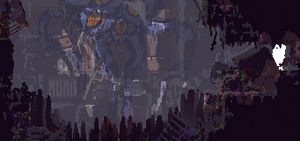
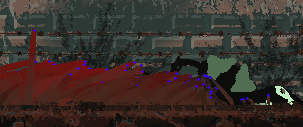
Pole Plants are ambush predators that disguise themselves as poles in an attempt to lure creatures into grabbing them.
Pole Plants are plantlike organisms consisting of a long, flexible stalk and numerous leaf-like appendages. The main stalk is black in coloration, while the largest, lowermost 'leaves' are bright red. Their 'leaves' flare outwards near the base of the stalk, decrease in length towards the center, and flare outwards and upwards towards the end.
While the Pole Plant is hidden, they wrap their 'leaves' around their stalk and stand straight out of the ground, closely resembling a pole. Pole Plants can be differentiated by poles by their slight reddish tinge and the absence of the 'rust spots' that are usually found on poles, making Pole Plants look unusually smooth compared to real poles.
If a Pole Plant is hit by a Rock, they enter an active state and writhe around. While active, they attempt to grab any nearby creatures. Activating a Pole Plant can be an effective way to get away from pursuing predators, such as ![]() Lizards, as most creatures are afraid of the Pole Plant. If Slugcat is grabbed, hitting the Pole Plant with a
Lizards, as most creatures are afraid of the Pole Plant. If Slugcat is grabbed, hitting the Pole Plant with a ![]() Rock or a
Rock or a ![]() Spear causes them to let go and allows Slugcat to escape.
Spear causes them to let go and allows Slugcat to escape.
Hitting a Pole Plant with a Spear causes them to writhe around in pain. In this panicked state, they cannot grab Slugcat, allowing them to retrieve their Spear before the Pole Plant retreats underground.
It is possible to distinguish Pole Plants from regular poles, as Pole Plants are much smoother than poles and have a reddish tint. Another way to spot Pole Plants is to view the map; as the map only shows solid geometry, 'poles' which are not visible on the map are hidden Pole Plants instead. Additionally, the ![]() Yellow Overseer can indicate a Pole Plant's location by showing the flashing red and yellow 'predator' warning symbol. Threat music also plays if a Pole Plant is in the room.
Yellow Overseer can indicate a Pole Plant's location by showing the flashing red and yellow 'predator' warning symbol. Threat music also plays if a Pole Plant is in the room.
While awaiting prey, the Pole Plant conceals themself as a regular pole and stays mostly still. A leaf or two may sometimes pop out as a creature walks past the Pole Plant. They may occasionally pulse their leaves outwards, revealing telltale flashes of red. If a creature stands at the base of a dormant Pole Plant for too long, the Pole Plant may attempt to grab them and pull them into their den.
When a creature grabs onto a Pole Plant, the Pole Plant reveals their true form, latches onto the creature tightly with their appendages, and proceeds to pull the creature into their den. If the creature manages to escape, the Pole Plant attempts to follow their movement in an attempt to recapture them.
The pull of a Pole Plant is strong enough to grab even large creatures such as ![]() Vultures.
Vultures.
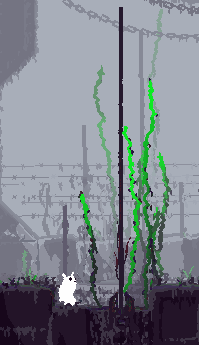
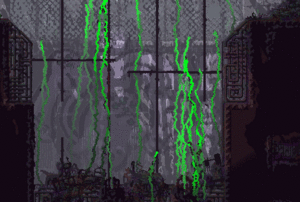
Monster Kelp are stationary predators often found in or around bodies of water, which hunt by dragging unsuspecting prey into their den.
Monster Kelp are plant-like organisms which consist of a long, thick stem and drooping leaf-like growths. Monster Kelp is primarily black in coloration, accented by red or green edges around their 'leaves'.
Monster Kelp present a large and mostly-stationary target, and as such are fairly easy to kill, dying in ~3 ![]() Spear hits. Monster Kelp writhe around when hit and cannot grab Slugcat while doing so; thrown Spears can be retrieved during this period. Targeting the base of the stem can make it easier to retrieve Spears, as it remains the most stationary while the Monster Kelp is writhing. Monster Kelp that are submerged in water or growing from walls or ceilings may be harder to retrieve Spears from and as such may require multiple Spears to kill.
Spear hits. Monster Kelp writhe around when hit and cannot grab Slugcat while doing so; thrown Spears can be retrieved during this period. Targeting the base of the stem can make it easier to retrieve Spears, as it remains the most stationary while the Monster Kelp is writhing. Monster Kelp that are submerged in water or growing from walls or ceilings may be harder to retrieve Spears from and as such may require multiple Spears to kill.
It is possible to sneak past Monster Kelp by moving slowly. This is possible on both land and water (although the water must not be disturbed by something such as a waterfall) and can be executed by tapping the move button a bit at a time. If this is performed successfully, the Monster Kelp does not react to the player.
Monster Kelp can be stunned long enough to get past by throwing a Spear, a ![]() Flashbang, or alternatively a
Flashbang, or alternatively a ![]() Rock (although this stuns it for a considerably shorter time) at it.
Rock (although this stuns it for a considerably shorter time) at it.
It is possible to distract Monster Kelp with objects that have player collision, such as ![]() Blue Fruit or hydrated
Blue Fruit or hydrated ![]() Bubble Fruit. Throwing one such object near or at the tip of their stem may prompt them to grab the object and retreat into their den with it, granting a decent window of time to pass through.
Bubble Fruit. Throwing one such object near or at the tip of their stem may prompt them to grab the object and retreat into their den with it, granting a decent window of time to pass through.
The base of the Monster Kelp remains stationary, but their flexible stem can move and attack other creatures. Monster Kelp remains still while no creatures are in sight. Upon detecting prey, Monster Kelp stretches towards them and follows their movement with the tip of their stem. If the tip makes contact with their prey, the creature is dragged into the Monster Kelp's den and killed. Monster Kelp hunt almost all creatures.
Monster Kelp have movement-based vision which takes the form of a full radial view from the tip of their stem. They are completely unable to hear.
